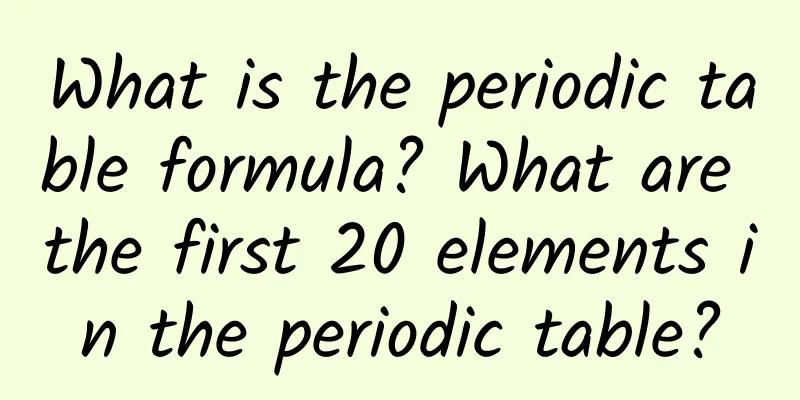What is the periodic table formula? What are the first 20 elements in the periodic table?

|
The periodic table of chemical elements is a list of chemical elements sorted from smallest to largest according to their atomic number. The list is generally rectangular, with spaces left in some periods so that elements with similar properties are grouped in the same family. In order to help people quickly memorize uncommon elements, a mnemonic for the periodic table was created. Let's read it together! Contents of this article 1. Periodic table formula 2. What are the first 20 elements in the periodic table? 3. In which region of the periodic table is iron located? 1Periodic table formulaThe mnemonics for the periodic table are: monovalent hydrogen, chlorine, potassium, sodium, silver; divalent oxygen, calcium, barium, magnesium, zinc; trivalent aluminum, tetravalent silicon, pentavalent phosphorus; divalent iron, trivalent iron, divalent carbon, tetravalent carbon; nitrogen from monovalent to pentavalent; divalent copper and mercury are the most common. There is also the periodic association memory method, which associates each element with words that are closer to our lives, making it easier to remember. Monovalent hydrogen, chlorine, potassium, sodium, and silver; divalent oxygen, calcium, barium, magnesium, and zinc; trivalent aluminum, tetravalent silicon, pentavalent phosphorus, divalent iron, trivalent iron, and divalent carbon; nitrogen is present from one to five valent; and divalent copper and mercury are the most common. Using this rhyming method of memory, you can quickly remember the chemical valence of each element. There is also periodic memory. The first period: hydrogen and helium, we can associate it with "invasion". The second period: lithium, beryllium, boron, carbon, nitrogen, oxygen, fluorine, and neon, we can associate it with carp skin holding carbon eggs and raising milk. The third period: sodium, magnesium, aluminum, silicon, phosphorus, sulfur, chlorine, and argon, we can associate it with the beautiful girl Guilin with green teeth. The fourth period: potassium, calcium, scandium, titanium, vanadium, chromium, and manganese can be associated with marrying, changing Kangtai, and becoming a counter-revolutionary; iron, cobalt, nickel, copper, zinc, gallium, and germanium can be associated with the iron aunt pinching the newly married woman; arsenic, selenium, bromine, and krypton can be associated with anger and shock. By following this memory method, you can quickly remember the periodic table. 2What are the first 20 elements in the periodic table?H hydrogen, He helium, Li lithium, Be beryllium, B boron, C carbon, N nitrogen, O oxygen, F fluorine, Ne neon, Na sodium, Mg magnesium, Al aluminum, Si silicon, P phosphorus, S sulfur, Cl chlorine, Ar argon, K potassium, Ca calcium. The periodic table of chemical elements is a list of chemical elements arranged from smallest to largest according to atomic number. The list is generally rectangular, with spaces left in some periods so that elements with similar properties are grouped in the same group, such as alkali metals, alkaline earth metals, halogen elements, and rare gases. This results in the formation of element partitions in the periodic table and is divided into seven main groups, seven sub-groups, group VIII, and group 0. Because the periodic table can accurately predict the properties of various elements and the relationships between them, it is widely used in chemistry and other scientific fields as a very useful framework for analyzing chemical behavior. 3In what region of the periodic table is iron located?Iron is located in the fourth period of the periodic table, group VIII. Iron is a metallic element with an atomic number of 26 and a chemical formula of Fe. Pure iron is white or silvery white with a metallic luster. It has a melting point of 1538°C and a boiling point of 2750°C. It is soluble in strong and medium-strong acids but insoluble in water. Iron has 0-valent, 2-valent, 3-valent, 4-valent, 5-valent and 6-valent states, of which 2-valent and 3-valent states are more common, while 4-valent, 5-valent and 6-valent states are less common. Iron is widely distributed in our daily life, accounting for 4.75% of the earth's crust, ranking fourth after oxygen, silicon and aluminum. Pure iron is a silvery-white metal with good ductility and flexibility. It is used to make the iron core of generators and motors. Iron and its compounds are also used to make magnets, medicines, inks, pigments, abrasives, etc. It is one of the so-called "black metals" in industry (the other two are chromium and manganese) (In fact, pure pig iron is silvery white. The iron element is called a "black metal" because the surface of iron is often covered with a protective film whose main component is black ferroferric oxide). In addition, the human body also contains iron. The divalent ferrous ion is an important component of hemoglobin and is used for oxygen transportation. |
<<: What are the main languages spoken in North America? Characteristics of North American rivers
Recommend
Why are girls' nipples black?
Why are nipples gray and black? Normally, the col...
What to do with spots on face after miscarriage?
Women are most likely to develop spots on their f...
Are Korean chili sauce and bibimbap sauce the same? How to process Korean chili sauce into bibimbap sauce
Friends who like sweet and spicy taste will defin...
Introduction to early symptoms of vulvar leukoplakia
We all know that many diseases have some signs be...
DIGITIMES Research: Global tablet shipments reached 38.4 million units in the third quarter of 2022, an increase of more than 20% month-on-month
According to the latest data from DIGITIMES Resea...
What is the reason for not getting pregnant after two years of sex?
A baby is very important to every family. A baby ...
This article will help you understand pain knowledge and eliminate misunderstandings
Author: Han Wenyong, Chief Physician of Beijing E...
Can honey water soften the cervix?
The cervix, also known as the uterine cervix, con...
How to calculate pregnancy days
When you are pregnant, you will have a due date. ...
Dull pain in lower left abdomen during pregnancy
During pregnancy, a woman's body will experie...
What should girls do if they suffer from lumbar muscle strain?
The reasons for lumbar muscle strain in different...
Can pregnant women eat onions?
There are many things you cannot eat during pregn...
Traditional Chinese Medicine Treatment of Vaginitis
Vaginitis is a relatively common female disease. ...
Do patients with high blood pressure feel dizzy?
Dizziness is a common symptom of patients with hy...
Pregnancy bleeding pictures
During pregnancy, couples need to be careful abou...









